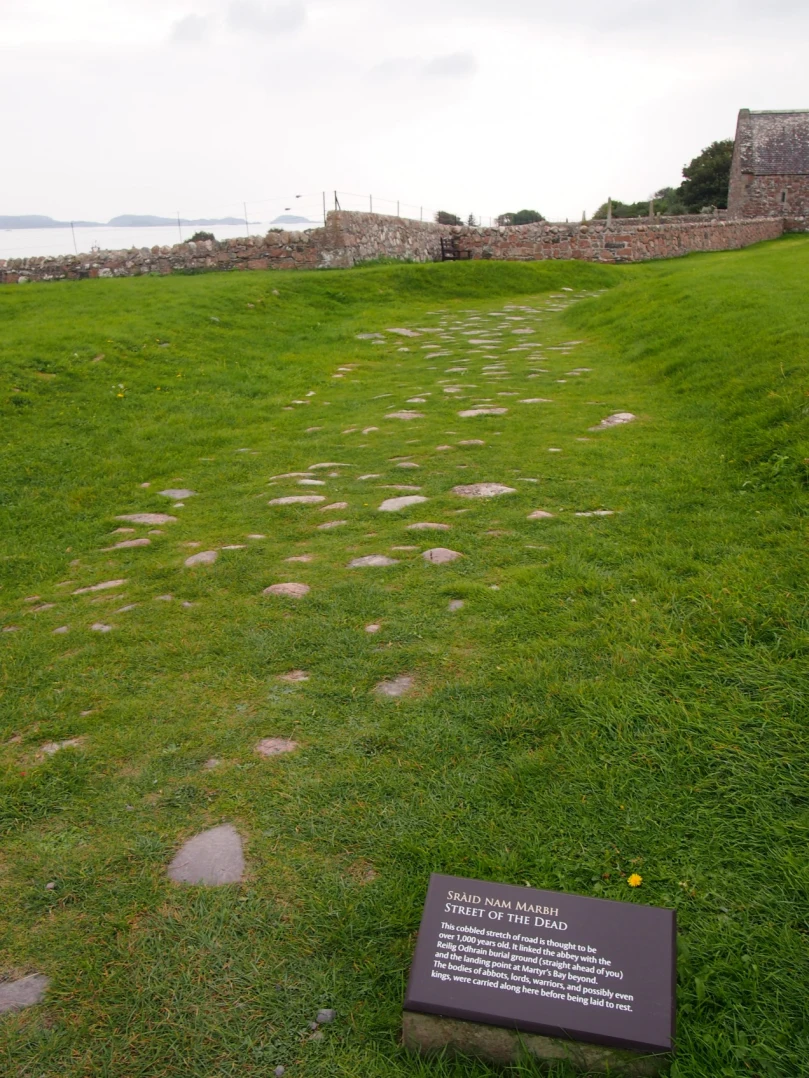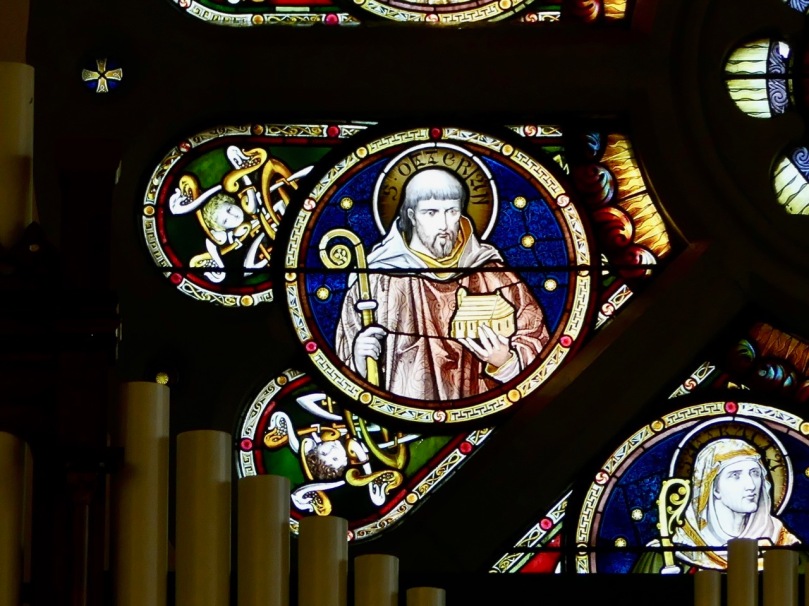This is the story of a man who became patron saint of two different places in Ireland – but is also considered the patron saint of atheists.
Wait – what? Atheists have a patron saint? Isn’t that like a complete oxymoron?
I think I’d better get on with the story. When we were in Lismore recently I visited the enormous and architecturally-interesting Catholic church called, (like the Church of Ireland Cathedral down the road) after St Carthage (AKA Mochuda or Mochua). In this church there is an impressive rose window, which I decided to feature on our Facebook page the other day. In doing so, I found I had to decipher the names of the saints, in an ancient script around their haloes. All of them were familiar to me except one – St Otteran. My quest to find out more about him led me to this story.
The Saints of Ireland, from top left, Patrick, Bridget, Declan, Dympna, Mochuda, Attracta, Otteran, Ita. I love that there is an equal number of male and female saints, even if the depiction is not very imaginative
Otteran is also spelled as Odhrán or Oran – I will use Oran for simplicity for the rest of this post. According to some accounts he was born in Britain, but his monastic career was first noted when he was an Abbot in Meath. However, he is revered in Tipperary where he established a monastic settlement and is honoured today as patron saint of the Silvermines Parish. There is a ruined church and a holy well dedicated to him in Latteragh, near Nenagh. See this lovely post about his church and holy well from our friend The Tipperary Antiquarian. He lived there for 40 years, therefore he must have been aged already when he went with St Columba (AKA Columcille) to Iona.
Photo courtesy of The Tipperary Antiquarian
St Columba voluntarily banished himself to Iona in 563 when he lost a judgement over a plagiarism incident. He took 12 disciples with him, Otteran being the oldest and therefore the first to die.
Columba blesses Derry as he prepares to depart from Iona – from a large stained glass window in St Eugene’s Cathedral, Derry
Columba went to visit him on his sick bed and that night he had a dream of two warring angels – a good angel and a bad angel, fighting over Otteran’s soul. Sure enough, he died the next day, and was the first person to be buried on the island.
St Oran’s Cross, believed to be from the 8th century has recently been restored (story here)
A small church with a wonderful Romanesque doorway is dedicated to him, but more importantly, the graveyard that eventually grew up around it was called Reilig Oran.
 This image, and the one below, has been borrowed with thanks (I hope she doesn’t mind) from a lovely Blog called Flickering Lamps. This post is “Rèilig Odhrain, the ancient cemetery on the edge of the world”
This image, and the one below, has been borrowed with thanks (I hope she doesn’t mind) from a lovely Blog called Flickering Lamps. This post is “Rèilig Odhrain, the ancient cemetery on the edge of the world”
Iona, located as it was on the extreme West coast of Scotland, was in those days a major stop along the marine highway. Irish, British, Scottish and Norse and Danish ships stopped. The Vikings did more than stop by – they sacked the monastery on two occasions, murdering the monks at a site afterwards called Martyr’s Bay.
 Sráid nam Marbh is the Street of the Dead. It is a Medieval paved road (very rare) leading from the Bay of Martyrs (the Vikings did it) to the Reilig
Sráid nam Marbh is the Street of the Dead. It is a Medieval paved road (very rare) leading from the Bay of Martyrs (the Vikings did it) to the Reilig
As the fame of Columba and his monastic settlement grew, the Island acquired a mystical reputation as a preferred place to be buried. According to tradition, 48 kings are buried there, including MacBeth and Duncan – kings of France, Scotland, Ireland and Norway.
This image, of grave slabs taken inside for safekeeping, is from the official Historic Environment Scotland page
The Scots eventually surrendered the island to Magnus, King of Norway in 1098 and the Norse Vikings continued to transport their kings to Iona for burial at Reilig Odhráin from all over their territory.
Image courtesy of A Tribute to Alexander Ritchie
And their territory was vast, and included several settlements in Ireland – Dublin, Wexford, Waterford, Cork and Limerick all started off as Viking sea-ports. In Waterford, honouring the burial place of their ancestors, the Vikings chose St Oran as the patron of their city. Thus, an Irish man who had never set foot in Waterford became one of its revered icons. Later, he also become patron of the diocese, along with Carthage of Lismore and of course St Declan of Ardmore. And don’t forget, he was already the Patron Saint of the Silvermines area in Tipperary.
Waterford celebrates its Viking and Norman heritage
But I said he is also the Patron Saint of Atheists – how could that have happened? Well, mainly it’s because there are two different stories about how he died on Iona, and it’s the second one that’s part of true Hebridean lore.
Image courtesy of A Tribute to Alexander Ritchie
When Columba arrived he set about building a church. But the builders became very frustrated because every morning when they arrived on site what they had built the day before had been knocked down. Columba prayed a mighty prayer and the answer came to him – what was required was a ‘foundation sacrifice’ – that means a human had to be buried alive under the church. According to some accounts, Oran was in fact Columba’s son, and Columba felt, therefore, he would be the most powerful sacrifice. According to others, Oran actually stepped forward and offered himself, in the assurance that this guaranteed his place in heaven.
Image courtesy of St Barnabas Orthodox Mission Kenya
He was buried and the church walls stayed up. However, three days later, while the monks were at prayer in the church, he arose, poked his head up and announced that he had seen what was on the other side. God is not as we imagine him, he said, There is no hell, and, while he was at it, nothing like heaven either. St Columba was horrified and ordered that earth be heaped on him to keep him down. There is even a Hebridean saying Uir, Uir, air suil Odhrain! mun labhair e tuille comhraidh, which translates as Earth, earth on Oran’s eyes, lest he further blab. More succinctly, an old Irish saying, apparently, is to say Throw mud in the mouth of St. Oran, when somebody is uttering uncomfortable truths.
St Columba as a monk (right) along with Patrick and Bridget, from St Mary’s Catholic church in Ballinrobe. Columba is usually shown with a book, since he is so strongly associated with the story of the copied manuscript. This window is by the Harry Clarke Studios
St Oran’s body, according to tradition, is still under the foundations. Or maybe not – another version has it that Columba had him reburied in consecrated ground and that once that was done he troubled them no more with his blabbing of the secrets of the next world. That consecrated ground became St Oran’s Graveyard – this ensuring his immortality in Waterford at least, if not in heaven.
Images from the Kickstarter Page (this one and the final GIF) for the movie The Grave of St Oran by Jim Blatt, based on Neil Gaiman’s poem
It turns out I am far from the only one who finds this tale, and its various nuances fascinating. None other than Neil Gaiman has written a poem, In Reilig Oran.
Neil Gaiman’s poem – a signed print is available here
And now that poem has been made into a stop-motion animation by Jim Batt, called The Grave of St Oran. The kickstarter campaign page will give you an idea what it will be like – and apparently it’s finished but I can find out nothing more about it. So look out for it coming at some point to a screen near you. This GIF is offered as a teaser on their project page (see link above). It depicts St Oran gazing out to sea – perhaps he is contemplating the decision he is about to make.
There are so many layers in this story, so many familiar tropes of mythology, heroic tales and biblical stories, but I don’t believe I have ever heard one quite like this before. Pointing out that none of this story made it into the Life of St Columba by Adamnán, The Blogger Nihil Obstat puts it this way in his post The Silencing of St Oran: The moral of this story is the same 15 centuries later. If even the most devoted follower of the faith reveals a revelation not in support of the preached version they are quickly silenced. And saints have their ugly or suspect actions edited out of their official biographies.
A high status individual is buried in St Oran’s Graveyard
Among the many feelings it’s left me with, though, is a strong desire to visit Iona. Future post!















Fr. Seraphim Aldea at Mull Monastery has a special devotion to St. Oran. Watch him speak about him in this YouTube video. I think you will find it interesting not only for the fact that Fr. Seraphim Aldea is an Orthodox hieromonk. I didn’t realize that the Orthodox Church commemorates many Celtic saints on their holy calendar, such as St. Columba.
LikeLike
Thanks so much – I look forward to watching that.
LikeLike
“Throwing mud in the mouth” that’s my da, now gone to be with the Saints.
LikeLike
Did he used to say that?
LikeLike
Have been following St. Colmcille and this guy for years, and visited Iona . . . a wonderful place, also Mull. Congrats on a great article, with so much text and illustrations!
LikeLike
Looking forward to seeing it myself some day. Thank you for your kind comments.
LikeLike
I am fascinated by Oran’s tale which seems to throw a dark light into the crossover from Celtic beliefs to Christianity.The human sacrifice aspect is real Wickerman stuff!
LikeLike
There are many parallels to this story in classical and folk mythology, as well as in the bible. It’s a familiar motif, I think.
LikeLike
Ah – so us atheists now have a patron saint. What a relief! 🙂 Great post!
LikeLike
Finally, one for you! 😊
LikeLike
I have to admit when I saw that window I wondered who St Otteran was and I think he’s now my new favourite saint! What a story. I think we need to come to Iona with you please!
LikeLike
Let’s plan it!
LikeLiked by 1 person
Oooh, yes!
LikeLike
Thought you might want to know: The moving icon of St Oran, in its decidedly non-Byzantine style, was produced on the island of Mull, which travelers must cross to get to Iona (unless they have their own boat). https://shop.mullmonastery.com/product/st-oran-of-iona-icon-of-holy-old-age/
LikeLike
I’m so glad to see this proper attribution, Sue – thanks so much. It’s a wonderful artwork.
LikeLike